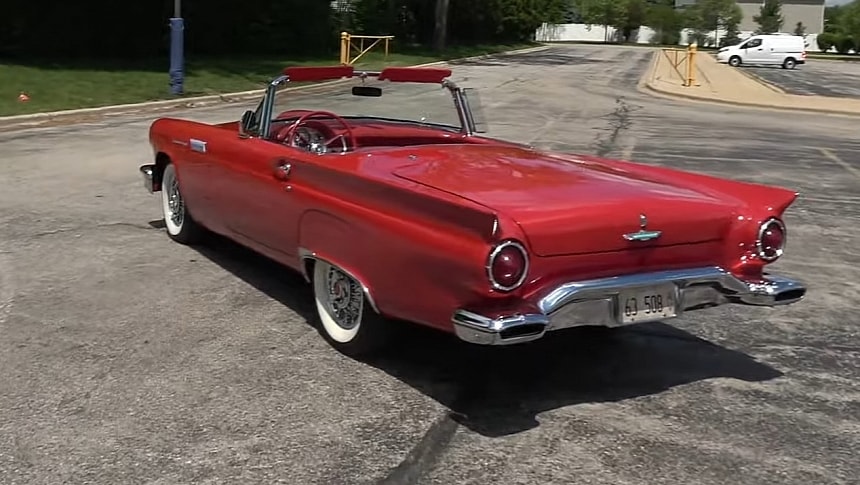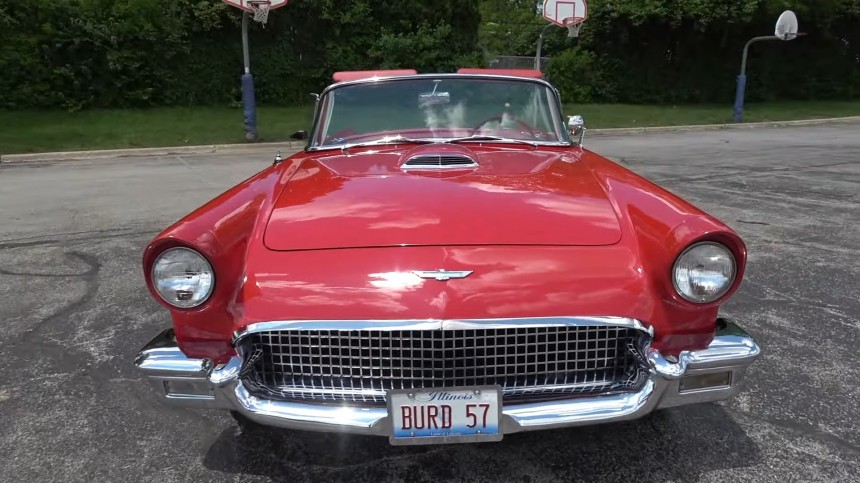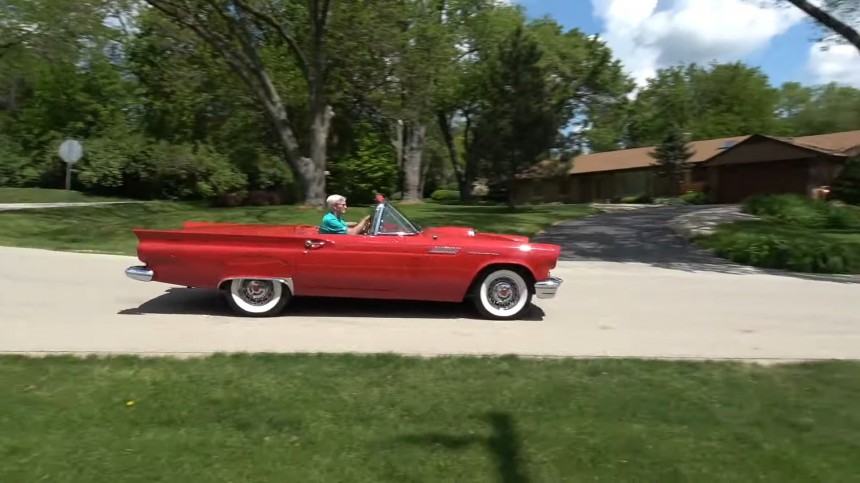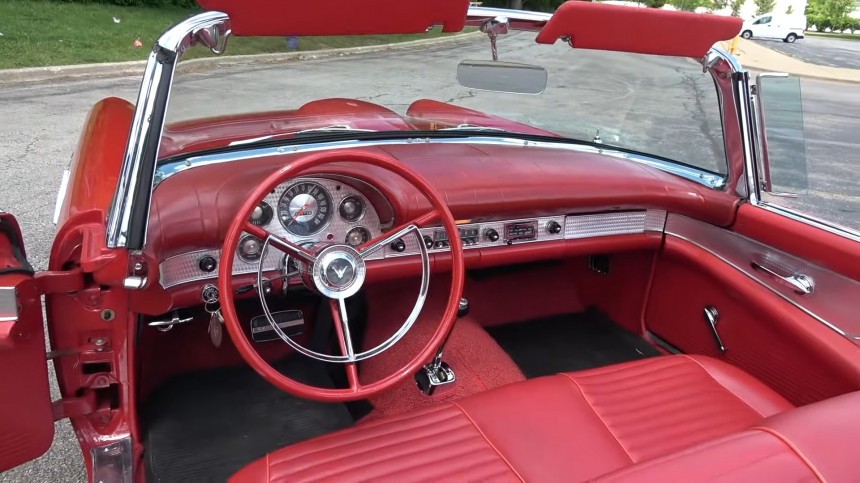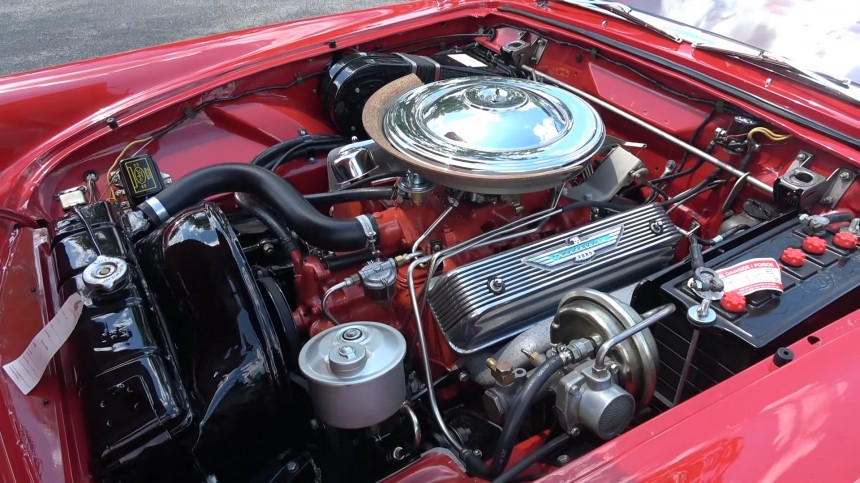So much fun! The car is pretty responsive, the steering is very light, it’s very easy to steer, and it’s got power brakes. The rivalry between Ford and Chevrolet for domestic supremacy started long ago. It will end when the world no longer uses cars. And even then, vintage automobiles will still remind humans of the year 14,000 PCE (Post Combustion Era) of great ages from the history of their ancestors (those would be us) and how they used to travel.
Tensions between General Motors' best-selling division and the backbone of Ford Motor Company got to unprecedented heights in the 50s when Chevrolet introduced a new car segment on its sales offers. The sportscar was by no means a new invention, and it certainly didn’t erupt on Planet Piston from the Bowtie offices. But Chevrolet did something so stupendously genius that it’s still a wonder no one else thought about it until then.
At least, none of the Big Three. The sportscar had been available either as a European import or a very limited production series from small companies (does the Woodill Wildfire ring a bell?). Chevrolet said ‘Corvette,’ and all of a sudden, America had its own sportscar. Amazingly, the idea caught on, albeit it was a fragile thought at the beginning, in 1953.
Three hundred sportscars were assembled for the model year, but 1954 raised hopes a dozen times, with 3,640 units built (and keep in mind production started very late, in December of 1953). However, the radical improvement in consumer preferences pushed GM brass hats to predict a 10,000-order avalanche for 1955.
Enter the Ford Thunderbird, the Blue Oval alternative two-seat automobile. However, Henry Ford II didn’t want to go head-to-head against Chevrolet. He mischievously had the new car marketed as a personal luxury automobile.‘ Advertising gimmick or not, it worked - 16,155 copies of the new petite automobile were ordered in its debut year. Let’s run the numbers and see just how well the public received the Ford.
The Corvette needed two entire model years to reach 3,900 units. The Thunderbird scored 3,500 orders in its first ten days on the market. By the end of the 1955 model year production, 16,155 T-birds had been sold. The trend continued in the following two years, with 15,631 units built in 1956 and culminating with 21,380 in 1957, the car’s final year of its first generation.
Would you like to know what the Corvette fared that year out of its 10,000-sportscars prophecy? Seven hundred, over fourteen times less than what the optimistic and overly enthusiastic Bowtie officials calculated. It was such a devastating blow that the very existence of the ‘Vette was put under a very big question mark. Luckily, someone had a brief stroke of genius and saved the nameplate.
In the meantime, the T-Bird minded its own business – and even decided to leave the whole ‘two-door, two-seat’ market for Chevrolet. Starting in 1958, the Thunderbird gained a back seat – and sales exploded. The production number of the redesigned Ford climbed to 37,892 despite a three-month delay in the start of assembly and bravely ignoring the Eisenhower recession.The second-generation T-Bird was one of the very few nameplates that achieved an increase in production in 1958 (the Rambler would be another, and the Corvette also fits the bill).
1957 was a landmark year for Ford, not only because the Thunderbird’s first generation ended production but also because it marked the end of the two-seat Fords for the following 25 years. Affectionately called ‘The Little Birds,’ the original ‘personal luxury cars‘ inadvertently spawned a genre that became a staple for all of Detroit in the following decades.
The 1957 examples are the most refined iterations of this first-gen production run, with many styling changes and several mechanical improvements. The opening phrase of this story belongs to a collector who owns a Ford Thunderbird from 1957, a Flame Red example (how else?) that will probably serve as the archetypal example for those far away humans a dozen millennia from now.
He has owned the car for a dozen years, but he had chased it for pretty much all his life. As a kid, he had the occasional privilege of polishing a brand-new T-Bird that belonged to his next-door neighbor. He caught the addiction but didn’t get his dream car until 45 years later. His persistence paid off with dividends because the red-on-red example he now owns is drop-dead gorgeous.
It’s also a droptop – all first-generation Ford Thunderbirds were convertibles but had an optional removable hardtop cover. Engine choices remained the same as in 1956 (but only as far as size was regarded) but offered more power. The base powerplant was the 292-cubic-inch V8 (4.8-liters), which now came accompanied by three versions of the 312-cube V8. The 5.1-liter engine started at 245 hp (248 PS) with a single four-barrel carburetor and pushed even higher with dual quads: 270 hp (274 PS).
There was a very limited production (some 190-odd examples) fitted with a Paxton supercharger that shot 300 hp to the rear wheels. Geroge Hansen is the man in the video. This Ford addict waited almost half a century to get his own Thunderbird. His example is the composed 245-hp variant. It’s probably more than enough for fun cruises under the sun, with the top down and a nice breeze.
A three-speed automatic with a 3.56 rear axle gives this bird its wings, but I noticed an interesting – and intriguing - feature. The data plate on the firewall says the Transmission code (1) should be a three-speed manual, which this Ford clearly isn’t. However, Mr. Hansen won an award at the Muscle Car and Corvette Nationals 2022 with a 1957 Ford Thunderbird. If this was that car, I doubt it would have gotten the distinction if something was off with it.
The odometer reads 83,976 miles (135,146 kilometers), and I know the car had been restored around 2008. Even with the renovation, it is probably the best-looking example on Earth, bar none (not just among fellow birds of the Ford feather, but of all classics).
At least, none of the Big Three. The sportscar had been available either as a European import or a very limited production series from small companies (does the Woodill Wildfire ring a bell?). Chevrolet said ‘Corvette,’ and all of a sudden, America had its own sportscar. Amazingly, the idea caught on, albeit it was a fragile thought at the beginning, in 1953.
Three hundred sportscars were assembled for the model year, but 1954 raised hopes a dozen times, with 3,640 units built (and keep in mind production started very late, in December of 1953). However, the radical improvement in consumer preferences pushed GM brass hats to predict a 10,000-order avalanche for 1955.
The Corvette needed two entire model years to reach 3,900 units. The Thunderbird scored 3,500 orders in its first ten days on the market. By the end of the 1955 model year production, 16,155 T-birds had been sold. The trend continued in the following two years, with 15,631 units built in 1956 and culminating with 21,380 in 1957, the car’s final year of its first generation.
Would you like to know what the Corvette fared that year out of its 10,000-sportscars prophecy? Seven hundred, over fourteen times less than what the optimistic and overly enthusiastic Bowtie officials calculated. It was such a devastating blow that the very existence of the ‘Vette was put under a very big question mark. Luckily, someone had a brief stroke of genius and saved the nameplate.
1957 was a landmark year for Ford, not only because the Thunderbird’s first generation ended production but also because it marked the end of the two-seat Fords for the following 25 years. Affectionately called ‘The Little Birds,’ the original ‘personal luxury cars‘ inadvertently spawned a genre that became a staple for all of Detroit in the following decades.
The 1957 examples are the most refined iterations of this first-gen production run, with many styling changes and several mechanical improvements. The opening phrase of this story belongs to a collector who owns a Ford Thunderbird from 1957, a Flame Red example (how else?) that will probably serve as the archetypal example for those far away humans a dozen millennia from now.
It’s also a droptop – all first-generation Ford Thunderbirds were convertibles but had an optional removable hardtop cover. Engine choices remained the same as in 1956 (but only as far as size was regarded) but offered more power. The base powerplant was the 292-cubic-inch V8 (4.8-liters), which now came accompanied by three versions of the 312-cube V8. The 5.1-liter engine started at 245 hp (248 PS) with a single four-barrel carburetor and pushed even higher with dual quads: 270 hp (274 PS).
There was a very limited production (some 190-odd examples) fitted with a Paxton supercharger that shot 300 hp to the rear wheels. Geroge Hansen is the man in the video. This Ford addict waited almost half a century to get his own Thunderbird. His example is the composed 245-hp variant. It’s probably more than enough for fun cruises under the sun, with the top down and a nice breeze.
The odometer reads 83,976 miles (135,146 kilometers), and I know the car had been restored around 2008. Even with the renovation, it is probably the best-looking example on Earth, bar none (not just among fellow birds of the Ford feather, but of all classics).
